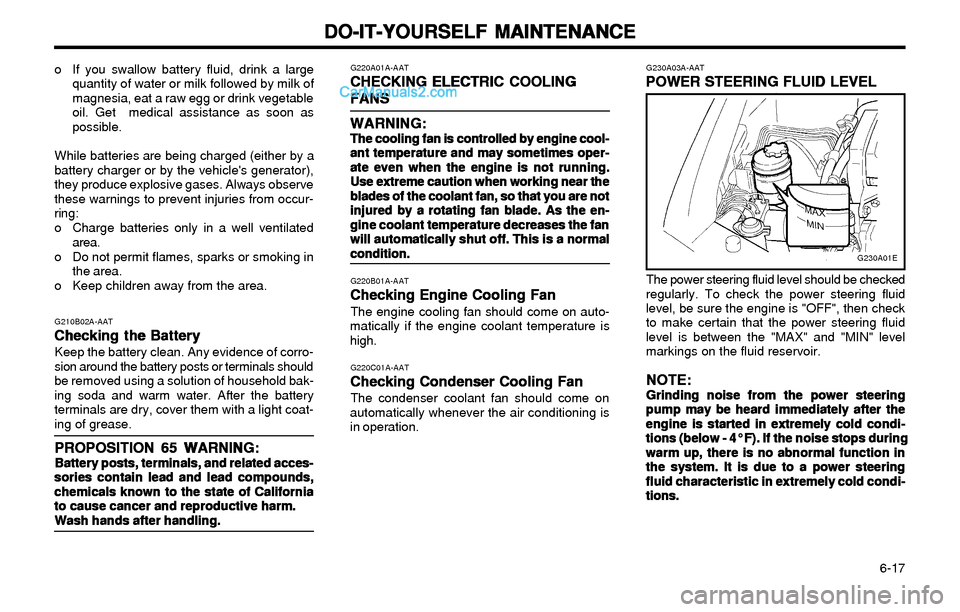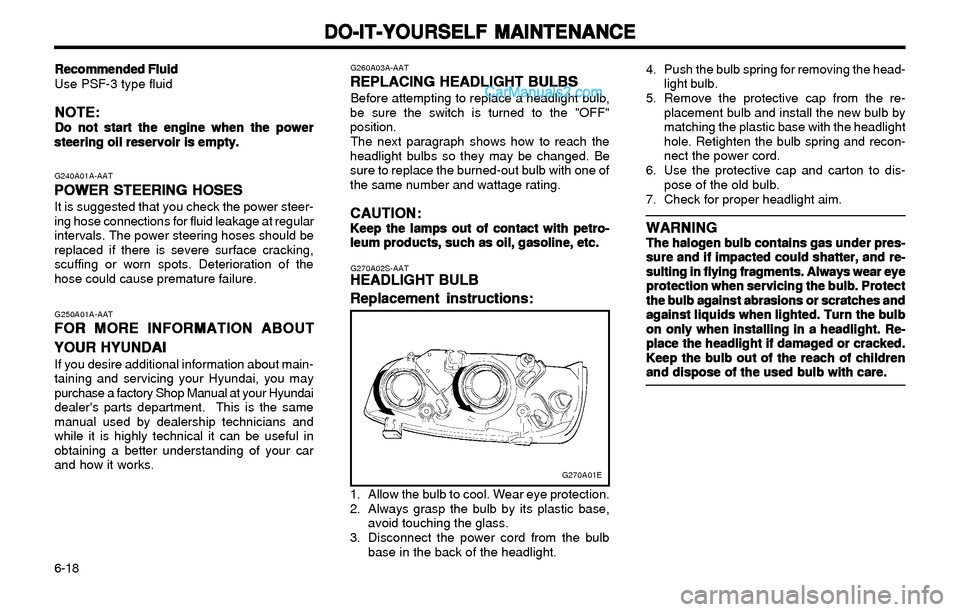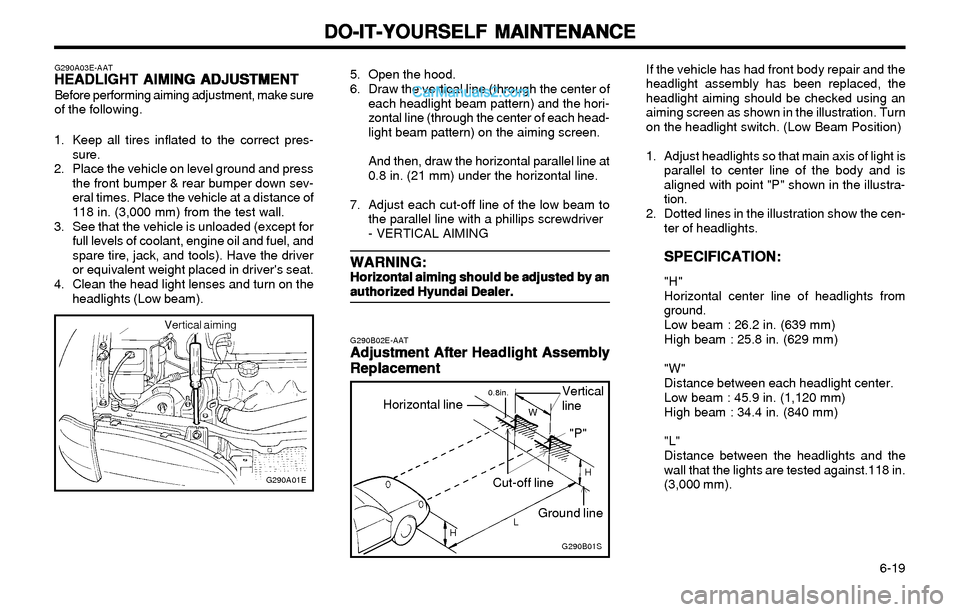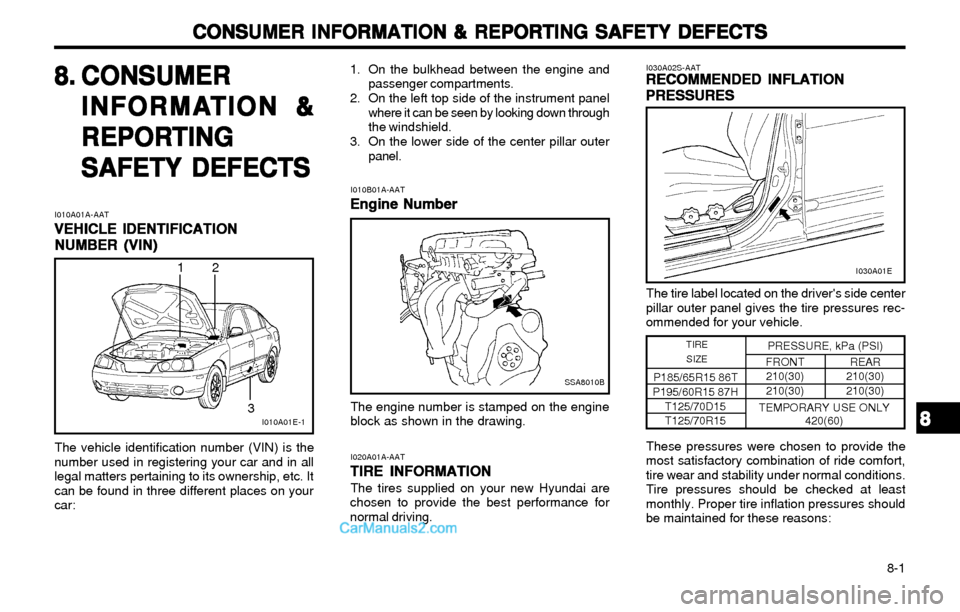2003 Hyundai Elantra check engine
[x] Cancel search: check enginePage 150 of 172

DO-IT-YOURSELF MAINTENANCE DO-IT-YOURSELF MAINTENANCEDO-IT-YOURSELF MAINTENANCE DO-IT-YOURSELF MAINTENANCE
DO-IT-YOURSELF MAINTENANCE
6-14
G160A01A-AAT
CHECKING CLUTCH PEDAL CHECKING CLUTCH PEDALCHECKING CLUTCH PEDAL CHECKING CLUTCH PEDAL
CHECKING CLUTCH PEDAL
FREE-PLAY FREE-PLAYFREE-PLAY FREE-PLAY
FREE-PLAY
With the engine off, press lightly on the clutch
pedal until you feel a change in resistance. This
is the clutch pedal free-play. The free-play should
be within the limits specified in the illustration. If
it is not, have it inspected by your Hyundai
dealer and adjusted or repaired if necessary.
G170A01A-AAT
CHECKING BRAKE PEDAL CHECKING BRAKE PEDALCHECKING BRAKE PEDAL CHECKING BRAKE PEDAL
CHECKING BRAKE PEDAL
FREE-PLAY FREE-PLAYFREE-PLAY FREE-PLAY
FREE-PLAY
With the engine off, press down on the brake
pedal several times to reduce the vacuum in the
brake booster.
Then, using your hand, press down slowly on
the brake pedal until you feel a change in
resistance. This is the brake pedal freeplay.
The freeplay should be within the limits speci-
fied in the illustration. If it is not, have it inspect-
ed by your Hyundai dealer and adjusted or
repaired if necessary.
G160A01E
0.24 ~ 0.51 in. (6 ~ 13 mm)
SSA6170A
0.12 ~ 0.31 in. (3 ~ 8 mm)
G180A01A-AAT
CHECKING BRAKE PEDAL CHECKING BRAKE PEDALCHECKING BRAKE PEDAL CHECKING BRAKE PEDAL
CHECKING BRAKE PEDAL
CLEARANCE CLEARANCECLEARANCE CLEARANCE
CLEARANCE
You need a helper to check the brake pedal
clearance. With the engine running, have your
helper press down on the brake pedal several
times and then hold it down with a force of about
110 lbs (50 kg, 490 N). The brake pedal clear-
ance is the distance from the top surface of the
brake pedal to the asphalt sheeting under the
floor mat.
If the brake pedal clearance is not within the
limits specified in the illustration, have it in-
spected by your Hyundai dealer and adjusted
or repaired if necessary.
SSA6180A
1.78 in. (45.1 mm)
Page 151 of 172

DO-IT-YOURSELF MAINTENANCE DO-IT-YOURSELF MAINTENANCEDO-IT-YOURSELF MAINTENANCE DO-IT-YOURSELF MAINTENANCE
DO-IT-YOURSELF MAINTENANCE
6-15
G200B01E-AAT
Replacing Accessory Fuse Replacing Accessory FuseReplacing Accessory Fuse Replacing Accessory Fuse
Replacing Accessory Fuse
The fuse box for the lights and other electrical
accessories will be found in the backside of multi
box located in the left side of driver. Inside the box
you will find a list showing the circuits protected
by each fuse.
If any of your car's lights or other electrical
accessories stop working, a blown fuse could
be the reason. If the fuse has burned out, you
will see that the metal strip inside the fuse has
burned through. If you suspect a blown fuse,
follow this procedure:
1. Turn off the ignition and all other switches.
2. Open the fuse box and examine each fuse.
Remove each fuse by pulling it toward you
(a small "fuse puller" tool is contained in the
fuse box to simplify this operation).
3. Be sure to check all other fuses even if you
find one that appears to have burned out.
B200B01E
G190A01A-AAT
CHECKING DRIVE BELTS CHECKING DRIVE BELTSCHECKING DRIVE BELTS CHECKING DRIVE BELTS
CHECKING DRIVE BELTS
G200A01A-AAT
CHECKING AND REPLACING CHECKING AND REPLACINGCHECKING AND REPLACING CHECKING AND REPLACING
CHECKING AND REPLACING
FUSES FUSESFUSES FUSES
FUSES
Replacing a Fusible Link Replacing a Fusible LinkReplacing a Fusible Link Replacing a Fusible Link
Replacing a Fusible Link
Drive belts should be checked periodically for
proper tension and adjusted if necessary. At the
same time, belts should be examined for cracks,
wear, fraying or other evidence of deterioration
and replaced if necessary.
Belt routing should also be checked to be sure
there is no interference between the belts and
other parts of the engine. After a belt is re-
placed, the new belt should be adjusted again
after two or three weeks to eliminate slack
resulting from initial stretching after use.A fusible link will melt if the electrical circuits
from the battery are ever overloaded, thus pre-
venting damage to the entire wiring harness.
(This could be caused by a short in the system
drawing too much current.) If this ever happens,
have a Hyundai dealer determine the cause,
repair the system and replace the fusible link.
The fusible links are located in a relay box for
easy inspection.
CAUTION: CAUTION:CAUTION: CAUTION:
CAUTION:When replacing a fusible link, never use When replacing a fusible link, never useWhen replacing a fusible link, never use When replacing a fusible link, never use
When replacing a fusible link, never use
anything but a new fusible link with the anything but a new fusible link with theanything but a new fusible link with the anything but a new fusible link with the
anything but a new fusible link with the
same or lower amperage rating. Never use a same or lower amperage rating. Never use asame or lower amperage rating. Never use a same or lower amperage rating. Never use a
same or lower amperage rating. Never use a
piece of wire or a higher-rated fusible link. piece of wire or a higher-rated fusible link.piece of wire or a higher-rated fusible link. piece of wire or a higher-rated fusible link.
piece of wire or a higher-rated fusible link.
This could result in serious damage and This could result in serious damage andThis could result in serious damage and This could result in serious damage and
This could result in serious damage and
create a fire hazard. create a fire hazard.create a fire hazard. create a fire hazard.
create a fire hazard.
SSA6190A
Water Pump Pulley
Generator Pulley
Crankshaft Pulley0.2 ~ 0.24 in.
(5.1 ~ 6 mm)
GoodBad
AS60310A
Page 153 of 172

DO-IT-YOURSELF MAINTENANCE DO-IT-YOURSELF MAINTENANCEDO-IT-YOURSELF MAINTENANCE DO-IT-YOURSELF MAINTENANCE
DO-IT-YOURSELF MAINTENANCE
6-17
G230A03A-AAT
POWER STEERING FLUID LEVEL POWER STEERING FLUID LEVELPOWER STEERING FLUID LEVEL POWER STEERING FLUID LEVEL
POWER STEERING FLUID LEVEL
The power steering fluid level should be checked
regularly. To check the power steering fluid
level, be sure the engine is "OFF", then check
to make certain that the power steering fluid
level is between the "MAX" and "MIN" level
markings on the fluid reservoir.
NOTE: NOTE:NOTE: NOTE:
NOTE:Grinding noise from the power steering Grinding noise from the power steeringGrinding noise from the power steering Grinding noise from the power steering
Grinding noise from the power steering
pump may be heard immediately after the pump may be heard immediately after thepump may be heard immediately after the pump may be heard immediately after the
pump may be heard immediately after the
engine is started in extremely cold condi- engine is started in extremely cold condi-engine is started in extremely cold condi- engine is started in extremely cold condi-
engine is started in extremely cold condi-
tions (below - 4°F). If the noise stops during tions (below - 4°F). If the noise stops duringtions (below - 4°F). If the noise stops during tions (below - 4°F). If the noise stops during
tions (below - 4°F). If the noise stops during
warm up, there is no abnormal function in warm up, there is no abnormal function inwarm up, there is no abnormal function in warm up, there is no abnormal function in
warm up, there is no abnormal function in
the system. It is due to a power steering the system. It is due to a power steeringthe system. It is due to a power steering the system. It is due to a power steering
the system. It is due to a power steering
fluid characteristic in extremely cold condi- fluid characteristic in extremely cold condi-fluid characteristic in extremely cold condi- fluid characteristic in extremely cold condi-
fluid characteristic in extremely cold condi-
tions. tions.tions. tions.
tions.
G230A01E G220A01A-AAT
CHECKING ELECTRIC COOLING CHECKING ELECTRIC COOLINGCHECKING ELECTRIC COOLING CHECKING ELECTRIC COOLING
CHECKING ELECTRIC COOLING
FANS FANSFANS FANS
FANS
WARNING: WARNING:WARNING: WARNING:
WARNING:
The cooling fan is controlled by engine cool- The cooling fan is controlled by engine cool-The cooling fan is controlled by engine cool- The cooling fan is controlled by engine cool-
The cooling fan is controlled by engine cool-
ant temperature and may sometimes oper- ant temperature and may sometimes oper-ant temperature and may sometimes oper- ant temperature and may sometimes oper-
ant temperature and may sometimes oper-
ate even when the engine is not running. ate even when the engine is not running.ate even when the engine is not running. ate even when the engine is not running.
ate even when the engine is not running.
Use extreme caution when working near the Use extreme caution when working near theUse extreme caution when working near the Use extreme caution when working near the
Use extreme caution when working near the
blades of the coolant fan, so that you are not blades of the coolant fan, so that you are notblades of the coolant fan, so that you are not blades of the coolant fan, so that you are not
blades of the coolant fan, so that you are not
injured by a rotating fan blade. As the en- injured by a rotating fan blade. As the en-injured by a rotating fan blade. As the en- injured by a rotating fan blade. As the en-
injured by a rotating fan blade. As the en-
gine coolant temperature decreases the fan gine coolant temperature decreases the fangine coolant temperature decreases the fan gine coolant temperature decreases the fan
gine coolant temperature decreases the fan
will automatically shut off. This is a normal will automatically shut off. This is a normalwill automatically shut off. This is a normal will automatically shut off. This is a normal
will automatically shut off. This is a normal
condition. condition.condition. condition.
condition.
G220B01A-AAT
Checking Engine Cooling Fan Checking Engine Cooling FanChecking Engine Cooling Fan Checking Engine Cooling Fan
Checking Engine Cooling FanThe engine cooling fan should come on auto-
matically if the engine coolant temperature is
high.
G220C01A-AAT
Checking Condenser Cooling Fan Checking Condenser Cooling FanChecking Condenser Cooling Fan Checking Condenser Cooling Fan
Checking Condenser Cooling FanThe condenser coolant fan should come on
automatically whenever the air conditioning is
in operation.
G210B02A-AAT
Checking the Battery Checking the BatteryChecking the Battery Checking the Battery
Checking the BatteryKeep the battery clean. Any evidence of corro-
sion around the battery posts or terminals should
be removed using a solution of household bak-
ing soda and warm water. After the battery
terminals are dry, cover them with a light coat-
ing of grease.
PROPOSITION 65 WARNING: PROPOSITION 65 WARNING:PROPOSITION 65 WARNING: PROPOSITION 65 WARNING:
PROPOSITION 65 WARNING:Battery posts, terminals, and related acces- Battery posts, terminals, and related acces-Battery posts, terminals, and related acces- Battery posts, terminals, and related acces-
Battery posts, terminals, and related acces-
sories contain lead and lead compounds, sories contain lead and lead compounds,sories contain lead and lead compounds, sories contain lead and lead compounds,
sories contain lead and lead compounds,
chemicals known to the state of California chemicals known to the state of Californiachemicals known to the state of California chemicals known to the state of California
chemicals known to the state of California
to cause cancer and reproductive harm. to cause cancer and reproductive harm.to cause cancer and reproductive harm. to cause cancer and reproductive harm.
to cause cancer and reproductive harm.
Wash hands after handling. Wash hands after handling.Wash hands after handling. Wash hands after handling.
Wash hands after handling.
o If you swallow battery fluid, drink a large
quantity of water or milk followed by milk of
magnesia, eat a raw egg or drink vegetable
oil. Get medical assistance as soon as
possible.
While batteries are being charged (either by a
battery charger or by the vehicle's generator),
they produce explosive gases. Always observe
these warnings to prevent injuries from occur-
ring:
o Charge batteries only in a well ventilated
area.
o Do not permit flames, sparks or smoking in
the area.
o Keep children away from the area.
Page 154 of 172

DO-IT-YOURSELF MAINTENANCE DO-IT-YOURSELF MAINTENANCEDO-IT-YOURSELF MAINTENANCE DO-IT-YOURSELF MAINTENANCE
DO-IT-YOURSELF MAINTENANCE
6-18Recommended Fluid Recommended FluidRecommended Fluid Recommended Fluid
Recommended Fluid
Use PSF-3 type fluid
NOTE: NOTE:NOTE: NOTE:
NOTE:Do not start the engine when the power Do not start the engine when the powerDo not start the engine when the power Do not start the engine when the power
Do not start the engine when the power
steering oil reservoir is empty. steering oil reservoir is empty.steering oil reservoir is empty. steering oil reservoir is empty.
steering oil reservoir is empty.
G240A01A-AAT
POWER STEERING HOSES POWER STEERING HOSESPOWER STEERING HOSES POWER STEERING HOSES
POWER STEERING HOSESIt is suggested that you check the power steer-
ing hose connections for fluid leakage at regular
intervals. The power steering hoses should be
replaced if there is severe surface cracking,
scuffing or worn spots. Deterioration of the
hose could cause premature failure.
G250A01A-AAT
FOR MORE INFORMATION ABOUT FOR MORE INFORMATION ABOUTFOR MORE INFORMATION ABOUT FOR MORE INFORMATION ABOUT
FOR MORE INFORMATION ABOUT
YOUR HYUNDAI YOUR HYUNDAIYOUR HYUNDAI YOUR HYUNDAI
YOUR HYUNDAI
If you desire additional information about main-
taining and servicing your Hyundai, you may
purchase a factory Shop Manual at your Hyundai
dealer's parts department. This is the same
manual used by dealership technicians and
while it is highly technical it can be useful in
obtaining a better understanding of your car
and how it works.
G260A03A-AAT
REPLACING HEADLIGHT BULBS REPLACING HEADLIGHT BULBSREPLACING HEADLIGHT BULBS REPLACING HEADLIGHT BULBS
REPLACING HEADLIGHT BULBSBefore attempting to replace a headlight bulb,
be sure the switch is turned to the "OFF"
position.
The next paragraph shows how to reach the
headlight bulbs so they may be changed. Be
sure to replace the burned-out bulb with one of
the same number and wattage rating.
CAUTION: CAUTION:CAUTION: CAUTION:
CAUTION:Keep the lamps out of contact with petro- Keep the lamps out of contact with petro-Keep the lamps out of contact with petro- Keep the lamps out of contact with petro-
Keep the lamps out of contact with petro-
leum products, such as oil, gasoline, etc. leum products, such as oil, gasoline, etc.leum products, such as oil, gasoline, etc. leum products, such as oil, gasoline, etc.
leum products, such as oil, gasoline, etc.
G270A02S-AATHEADLIGHT BULB HEADLIGHT BULBHEADLIGHT BULB HEADLIGHT BULB
HEADLIGHT BULB
Replacement instructions: Replacement instructions:Replacement instructions: Replacement instructions:
Replacement instructions:
1. Allow the bulb to cool. Wear eye protection.
2. Always grasp the bulb by its plastic base,
avoid touching the glass.
3. Disconnect the power cord from the bulb
base in the back of the headlight.
G270A01E
4. Push the bulb spring for removing the head-
light bulb.
5. Remove the protective cap from the re-
placement bulb and install the new bulb by
matching the plastic base with the headlight
hole. Retighten the bulb spring and recon-
nect the power cord.
6. Use the protective cap and carton to dis-
pose of the old bulb.
7. Check for proper headlight aim.
WARNING WARNINGWARNING WARNING
WARNINGThe halogen bulb contains gas under pres- The halogen bulb contains gas under pres-The halogen bulb contains gas under pres- The halogen bulb contains gas under pres-
The halogen bulb contains gas under pres-
sure and if impacted could shatter, and re- sure and if impacted could shatter, and re-sure and if impacted could shatter, and re- sure and if impacted could shatter, and re-
sure and if impacted could shatter, and re-
sulting in flying fragments. Always wear eye sulting in flying fragments. Always wear eyesulting in flying fragments. Always wear eye sulting in flying fragments. Always wear eye
sulting in flying fragments. Always wear eye
protection when servicing the bulb. Protect protection when servicing the bulb. Protectprotection when servicing the bulb. Protect protection when servicing the bulb. Protect
protection when servicing the bulb. Protect
the bulb against abrasions or scratches and the bulb against abrasions or scratches andthe bulb against abrasions or scratches and the bulb against abrasions or scratches and
the bulb against abrasions or scratches and
against liquids when lighted. Turn the bulb against liquids when lighted. Turn the bulbagainst liquids when lighted. Turn the bulb against liquids when lighted. Turn the bulb
against liquids when lighted. Turn the bulb
on only when installing in a headlight. Re- on only when installing in a headlight. Re-on only when installing in a headlight. Re- on only when installing in a headlight. Re-
on only when installing in a headlight. Re-
place the headlight if damaged or cracked. place the headlight if damaged or cracked.place the headlight if damaged or cracked. place the headlight if damaged or cracked.
place the headlight if damaged or cracked.
Keep the bulb out of the reach of children Keep the bulb out of the reach of childrenKeep the bulb out of the reach of children Keep the bulb out of the reach of children
Keep the bulb out of the reach of children
and dispose of the used bulb with care. and dispose of the used bulb with care.and dispose of the used bulb with care. and dispose of the used bulb with care.
and dispose of the used bulb with care.
Page 155 of 172

DO-IT-YOURSELF MAINTENANCE DO-IT-YOURSELF MAINTENANCEDO-IT-YOURSELF MAINTENANCE DO-IT-YOURSELF MAINTENANCE
DO-IT-YOURSELF MAINTENANCE
6-19
If the vehicle has had front body repair and the
headlight assembly has been replaced, the
headlight aiming should be checked using an
aiming screen as shown in the illustration. Turn
on the headlight switch. (Low Beam Position)
1. Adjust headlights so that main axis of light is
parallel to center line of the body and is
aligned with point "P" shown in the illustra-
tion.
2. Dotted lines in the illustration show the cen-
ter of headlights.
SPECIFICATION: SPECIFICATION:SPECIFICATION: SPECIFICATION:
SPECIFICATION:
"H"
Horizontal center line of headlights from
ground.
Low beam : 26.2 in. (639 mm)
High beam : 25.8 in. (629 mm)
"W"
Distance between each headlight center.
Low beam : 45.9 in. (1,120 mm)
High beam : 34.4 in. (840 mm)
"L"
Distance between the headlights and the
wall that the lights are tested against.118 in.
(3,000 mm).
G290B02E-AATAdjustment After Headlight Assembly Adjustment After Headlight AssemblyAdjustment After Headlight Assembly Adjustment After Headlight Assembly
Adjustment After Headlight Assembly
Replacement ReplacementReplacement Replacement
Replacement
G290A03E-AATHEADLI HEADLIHEADLI HEADLI
HEADLI
GHT AIMING ADJUSTMENT GHT AIMING ADJUSTMENTGHT AIMING ADJUSTMENT GHT AIMING ADJUSTMENT
GHT AIMING ADJUSTMENTBefore performing aiming adjustment, make sure
of the following.
1. Keep all tires inflated to the correct pres-
sure.
2. Place the vehicle on level ground and press
the front bumper & rear bumper down sev-
eral times. Place the vehicle at a distance of
118 in. (3,000 mm) from the test wall.
3. See that the vehicle is unloaded (except for
full levels of coolant, engine oil and fuel, and
spare tire, jack, and tools). Have the driver
or equivalent weight placed in driver's seat.
4. Clean the head light lenses and turn on the
headlights (Low beam).
G290A01E
G290B01S
Vertical
line
Cut-off line
Ground line Horizontal line
LW
H
H
"P"
0.8in.
Vertical aiming
5. Open the hood.
6. Draw the vertical line (through the center of
each headlight beam pattern) and the hori-
zontal line (through the center of each head-
light beam pattern) on the aiming screen.
And then, draw the horizontal parallel line at
0.8 in. (21 mm) under the horizontal line.
7. Adjust each cut-off line of the low beam to
the parallel line with a phillips screwdriver
- VERTICAL AIMING
WARNING: WARNING:WARNING: WARNING:
WARNING:Horizontal aiming should be adjusted by an Horizontal aiming should be adjusted by anHorizontal aiming should be adjusted by an Horizontal aiming should be adjusted by an
Horizontal aiming should be adjusted by an
authorized Hyundai Dealer. authorized Hyundai Dealer.authorized Hyundai Dealer. authorized Hyundai Dealer.
authorized Hyundai Dealer.
Page 159 of 172

CONSUMER INFORMATION & REPORTING SAFETY DEFECTS CONSUMER INFORMATION & REPORTING SAFETY DEFECTSCONSUMER INFORMATION & REPORTING SAFETY DEFECTS CONSUMER INFORMATION & REPORTING SAFETY DEFECTS
CONSUMER INFORMATION & REPORTING SAFETY DEFECTS
8-1
TEMPORARY USE ONLY
420(60)
8. 8.8. 8.
8.
CONSUMER CONSUMERCONSUMER CONSUMER
CONSUMER
INFORMA INFORMAINFORMA INFORMA
INFORMA
TION & TION &TION & TION &
TION &
REPOR REPORREPOR REPOR
REPOR
TING TINGTING TING
TING
SAFETY DEFECTS SAFETY DEFECTSSAFETY DEFECTS SAFETY DEFECTS
SAFETY DEFECTSI030A02S-AATRECOMMENDED INFLATION RECOMMENDED INFLATIONRECOMMENDED INFLATION RECOMMENDED INFLATION
RECOMMENDED INFLATION
PRESSURES PRESSURESPRESSURES PRESSURES
PRESSURES
The tire label located on the driver's side center
pillar outer panel gives the tire pressures rec-
ommended for your vehicle.
I030A01E
I010A01A-AAT
VEHICLE IDENTIFICATION VEHICLE IDENTIFICATIONVEHICLE IDENTIFICATION VEHICLE IDENTIFICATION
VEHICLE IDENTIFICATION
NUMBER (VIN) NUMBER (VIN)NUMBER (VIN) NUMBER (VIN)
NUMBER (VIN)
The vehicle identification number (VIN) is the
number used in registering your car and in all
legal matters pertaining to its ownership, etc. It
can be found in three different places on your
car:1. On the bulkhead between the engine and
passenger compartments.
2. On the left top side of the instrument panel
where it can be seen by looking down through
the windshield.
3. On the lower side of the center pillar outer
panel.
I010B01A-AAT
Engine Number Engine NumberEngine Number Engine Number
Engine Number
The engine number is stamped on the engine
block as shown in the drawing.
I020A01A-AAT
TIRE INFORMATION TIRE INFORMATIONTIRE INFORMATION TIRE INFORMATION
TIRE INFORMATION
The tires supplied on your new Hyundai are
chosen to provide the best performance for
normal driving.
SSA8010B
I010A01E-1
12
3
8 88 8
8
These pressures were chosen to provide the
most satisfactory combination of ride comfort,
tire wear and stability under normal conditions.
Tire pressures should be checked at least
monthly. Proper tire inflation pressures should
be maintained for these reasons:
TIRE
SIZEPRESSURE, kPa (PSI)
P185/65R15 86T
P195/60R15 87H
T125/70D15
T125/70R15REAR
210(30)
210(30) FRONT
210(30)
210(30)
Page 166 of 172

VEHICLE SPECIFICATIONS VEHICLE SPECIFICATIONSVEHICLE SPECIFICATIONS VEHICLE SPECIFICATIONS
VEHICLE SPECIFICATIONS
9-22.0 L
PFR5N-11 (PLATINUM)
RC10PYP4 (PLATINUM)
BTDC 8° ± 5°
SH, SG or SG/CD (API) and ABOVE
multigrade and fuel-efficient oil2.0 L SULEV
IFR5G-11 (IRIDIUM)
-
BTDC 9° ± 5°
SH(API) or GF-I (ILSAC) and ABOVE
multigrade and fuel-efficient oil SPECIFICATIONS
2.0L 4 Cylinder in-line DOHC
700 ± 100 (A/CON OFF)
750 ± 100 (A/CON ON)
0.039 ~ 0.043 in. (1.0 ~ 1.1 mm)
0.0067 ~ 0.0091 in. (0.17 ~ 0.23 mm)
0.0098 ~ 0.0122 in. (0.25 ~ 0.31 mm)
0.0047 ~ 0.011 in. (0.12 ~ 0.28 mm)
0.0079 ~ 0.015 in. (0.20 ~ 0.38 mm)
1 - 3 - 4 - 2 ITEMS
Engine Type
Idle Speed (RPM)
Spark Plug
Spark Plug Gap
Valve Clearance
(Cold engine : 20±5°C)
Ignition Timing (Base)
Firing Order
Oil Grade
J070A04E-AAT
ENGINE ENGINEENGINE ENGINE
ENGINE
NGK
CHAMPION
For adjusting
For checkingIntake
Exhaust
Intake
Exhaust
Page 169 of 172

INDEX INDEXINDEX INDEX
INDEX
10-2Driving
Economical driving ............................................................... 2-9 ~ 2-10
Smooth cornering ..........................................................................2-10
Winter driving ................................................................................2-10
E EE E
E
Emissions Control Systems ................................................................ 7-1
Engine
Before starting the engine ............................................................... 2-2
Compartment.......................................................................... 6-1 ~ 6-2
Coolant............................................................................................ 6-5
Coolant temperature gauge ...........................................................1-33
If the engine overheats ................................................................... 3-2
Number............................................................................................ 8-1
Oil .................................................................................................... 6-3
Starting ............................................................................................ 2-3
Engine Exhaust Can Be Dangerous ................................................... 2-1
F FF F
F
Floor Mat Anchor ..............................................................................1-49
Front Fog Light Switch ......................................................................1-36
Front Seats
Adjustable front seats ..................................................................... 1-7
Adjustable headrests ....................................................................... 1-8
Adjusting seatback angle ................................................................ 1-7
Adjusting seat forward and rearward .............................................. 1-7
Lumbar support control ................................................................... 1-8
Seat cushion height adjustment ...................................................... 1-8
Fuel
Capacity .......................................................................................... 9-1
Gauge............................................................................................1-32
Recommendations........................................................................... 1-1
Fuel Filler Lid
Remote release .............................................................................1-49Fuses ................................................................................................6-15
G GG G
G
General Everyday Checks .................................................................. 6-3
Glove box ..........................................................................................1-44
H HH H
H
Hazard Warning System ...................................................................1-39
Headlight Aiming Adjustment ................................................. 6-18 ~ 6-19
Headlight Bulb ...................................................................................6-18
Heating and Ventilation
Air flow control ..............................................................................1-55
Air intake control ...........................................................................1-55
Bi-level heating ..............................................................................1-56
Fan speed control .........................................................................1-54
Heating controls ............................................................................1-56
Temperature control ......................................................................1-56
High-mounted Rear Stoplight ............................................................1-47
Hood Release ...................................................................................1-48
Horn ..................................................................................................1-52
I II I
I
Ignition Switch ..................................................................................... 2-2
Illuminated Ignition Switch ................................................................... 1-2
Instrument Cluster and Indicator ............................................ 1-28 ~ 1-29
Instrument Panel Light Control .........................................................1-40
Instruments and Controls ..................................................................1-27
Interior Light
Interior light ...................................................................................1-44
Map light ........................................................................................1-43
Intermittent Wiper ..............................................................................1-38
J JJ J
J
Jump Starting ...................................................................................... 3-1